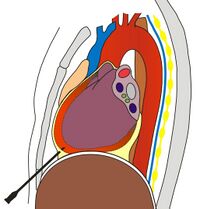Pericardiocentesis
From WikiLectures
It is a puncture of pericardium to evacuate pericardial fluid.
- In hospital conditions, it is performed under echocardiographic control, which minimizes complications and allows subsequent insertion of a thin drain.
- In the field, the pericardium is punctured so-called blindly.
- The patient assumes a semi-sitting position.
- The epidural needle is inserted to the left of the xiphoid process at an angle of about 45 ° below the ribs towards the left nipple.
- With constant aspirations, we approach the heart.
- We are waiting for a faint thud signaling the penetration of the pericardium and the subsequent aspiration of blood/serous fluid/air.
- After aspiration of blood, a small amount of blood is sprayed out and monitored for clotting. Blood from the pericardial space does not contain fibrin and therefore does not clot.
- Exercise carries the risk of pericardial and cardiac laceration or injuries coronary artery or lungs.
- Lethality of blind pericardiocentesisis around 20%.
Links[edit | edit source]
Related articles[edit | edit source]
References[edit | edit source]
Sources[edit | edit source]
- VANĚK, Ivan, et al. Cardiovascular Surgery. 1. edition. Praha : Karolinum, 2003. 236 pp. ISBN 8024605236.
- VAVRUŠOVÁ, B – DOČKALOVÁ, P – PUDIL, J. Tupá poranění srdce [online]. ©2006. [cit. 2010-09-20]. <http://www.zachranarivlockari.wz.cz/download/tupe_srdce.pdf>.

